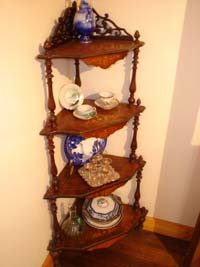Whatnot

A caller asked about the word whatnot. I said that it was a convenient filler or replacement when we can’t think of a specific term, something like thingamabob or thingamajig. That prompted an e-mail from another listener, Teresa K. Fowler of Naubinway:
"What-not" is not just another placeholder name like "whatchamacallit." Webster's New Collegiate Dictionary says a "what-not" is also a light, open set of shelves used to display bric-a-brac (i.e. collectible thingamajigs) which often included cups and saucers, knickknacks and figurines, according to Don Butkovich, Traverse City antiques appraiser. What the English call a "what-not" is similar to the French "etagere." It comes in several forms, and often is a backless sets of shelves, joined by spindles, and tiered or stacked backward like a layered cake. These were popular from approximately 1850 to 1950 among English, French, German, Belgian and other families, Butkovich said. A what-not might stand alone on the floor, or might be made to hang in a corner or stand on top of a dresser. Butkovich said current usage among antiques writers calls for hyphenating "what-not." He deals in 18th- and 19th-century American and European antiques and art, and says this barely scratches the surface of what is known about what-nots.
I appreciate the time and trouble that Teresa took to provide such solid details. As with many words, whatnot carries several meanings and shades of meaning. The Oxford English Dictionary tells us that it first appeared with a meaning that it still retains today:
Anything whatever; everything; ‘anything and everything’; ‘all sorts of things’: mostly, now only, as final item of an enumeration: = anything else, various things besides; ‘whatever you like to call it’. 1540 PALSGR. Acolastus V. ii. Yiijb, "Excesse of fleshely pleasures.. hath taken awaye all thynges..my goodes or substance, my good name and fame, my frendes, my glory, my renoume or estimation, what not? What thyng is it that she hath not taken from me?"
Almost 300 years later, it took on the meaning that Teresa detailed: An article of furniture consisting of an open stand with shelves one above another, for keeping or displaying various objects, as ornaments, curiosities, books, papers, etc. 1808 LADY S. LYTTELTON Correspondence. (1902) 54 "The old chairs, tables, what-nots, and sofas."
The Online Etymology Dictionary adds that the furniture took its name from the objects that it is meant to hold.


Comments